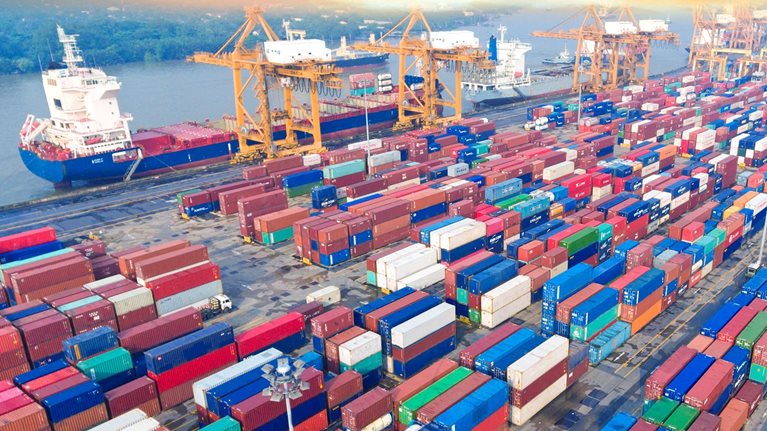The OECD’s composite leading indicators are showing signs of a rebound across economies, though the majority are still below the long-term trend (Exhibit 1). Nevertheless, while consumer spending contracted compared with the previous year—with a particular slowdown in consumption observed in China—consumer confidence appears to be building. In the United States, the Conference Board’s Consumer Confidence Index rose again in July to reach 117.0 (its highest level since July 2021). In India, retailers reported a notable 9% year-over-year increase in sales for July, while in Brazil, consumer confidence climbed to 94.8 (up from 92.3 in June) to reach its highest level since January 2019. The recovery in private consumption also continued in Russia, with retail sales in the second quarter growing 9.0–10.0% year over year, despite a small cumulative drop of 1.2% in May–June.

Inflation presents a mixed picture, showing persistence in some countries: notably, the rapid pace of price rises in the United Kingdom has been more persistent than in other big economies, with inflation running at the highest level among the G-7. The US consumer price index (CPI) increased to 3.2% (annualized) in July (3.0% in June), although core inflation ticked down to 4.7% (annualized) in July (4.8% in June). Eurozone inflation was down to 5.3% in July (5.5% in June), propelled primarily by inflation in food prices (10.8% in July); the latest reading for producer-price inflation was –2.7% in June (–1.1% in May). UK CPI inflation fell to 6.8% in July (7.9% in June), while core inflation (which excludes the price of energy, food, alcohol, and tobacco) remained unchanged at 6.9%. In India, official headline inflation took a pronounced leap from 4.9% in June to 7.5% in July, driven mainly by mounting food prices. In July, inflation in Brazil rose for the first time since June 2022, to 3.99% (3.16% in June), although consumer inflation remains below the Central Bank’s upper target of 4.75% for the fifth consecutive month. In July, inflation in Russia picked up to 4.3% year over year.
Europe saw the European Central Bank raise its key interest rate by 25 basis points to 3.50% in June and again to 3.75% in July, while the Bank of England hiked its policy rate by 25 basis points to 5.25% in August and is anticipated to raise rates further before the end of 2023. The Bank of Russia increased its key rate by 100 basis points in July and by a further 350 basis points in August, to 12%. Meanwhile, Brazil’s Monetary Policy Committee (COPOM) cut its key Selic rate by 0.50 percentage points to 13.25% in July (from 13.75% in June) after eight months with no change. A second cut of 0.5% will be applied in September.
India outshone other economies, achieving a growth rate of 7.8% in the second quarter of 2023. In that same quarter, the eurozone saw growth rates of 0.3% quarter over quarter and 0.6% year over year, although there is significant disparity among member countries. Ireland’s growth of 3.3% (the biggest in the eurozone) distorts the overall picture because of large swings caused by major international companies setting their headquarters there. France and Spain were in line with the eurozone average, growing 0.5% and 0.4% respectively; Germany, the eurozone’s largest economy, stagnated, and Italy performed even worse with a contraction of –0.3%. Updated forecasts from the International Monetary Fund (IMF) in July revised UK GDP growth for 2023 up to 0.4% (from –0.3%) and still expect 1.0% growth in 2024. India eclipsed Europe’s performance, achieving an economic growth rate of 6.1% in the first quarter of 2023, primarily driven by investments and net exports.
Manufacturing continues to be subdued, while the services outlook is softening. A downturn in services began in July across multiple countries (Exhibit 2), but India presented the fastest growth in almost a decade as the purchasing managers’ index (PMI) for services reached a 13-year high.

In the United States, the industrial production index rose slightly in July to 102.9 (102.0 in June). The manufacturing PMI was up to 49.0 in July (46.3 in June). In the eurozone, industrial activity data still point to a contraction. The Manufacturing PMI Output Index rose to 43.7 in the flash estimate for August (42.7 in July). The UK manufacturing sector remained in contraction territory in July, with output, new orders, and employment all suffering further decline and the manufacturing PMI falling to a six-month low of 45.3 (and below the neutral 50.0 mark for 11 successive months). Brazil’s manufacturing PMI rose from 46.6 in June to 47.8 in July, but remained below 50.0 for the ninth consecutive month. In India, industrial production (a crucial gauge of economic vitality) underwent a notable shift: after robust 5.3% year-over-year growth in May, the pace slowed to 3.7% in June.
Would you like to learn more about the McKinsey Global Institute?
By contrast, India’s services sector PMI surged to 62.3 in July (58.5 in June and 61.2 in May). The US services PMI declined again, to 52.3 in July (54.4 in June), while the eurozone services PMI dropped to a 30-month low of 48.3 in August (50.9 in July). The UK services PMI declined to 51.5 in June from 53.7 in May but remained above the 50.0 neutral value for the fifth consecutive month. Brazil’s services PMI dropped to 50.2 in July from 53.3 in June.
The labor market is still tight in many countries. In the United States, July’s unemployment rate changed little at 3.5%, slightly lower than June’s 3.6% (3.5% in January 2020). In the United Kingdom, the unemployment rate for April–June 2023 was up by 0.3 percentage points from the previous quarter to 4.2%, the largest quarterly increase since August–October 2021. In China, the surveyed urban unemployment rate ticked up to 5.3% in July (5.2% in June).
Across countries, equity markets put on a mixed performance with gains in July and, predominantly, declines in August. In July, year-to-date returns for the S&P 500 and the Dow Jones were up to 19.5% and 8.3% respectively. European equities have fallen since the beginning of August.
In terms of trade, global supply chain pressures are close to their lowest since 1998, but trade volumes have been dropping. In April, world trade volumes fell –1.4% on a monthly basis. In May, the Container Throughput Index edged up to 123.4 points, though European throughput continues to fall, while Chinese ports continue to strengthen. In China, the contraction of overall cross-border trade deepened in July, declining –13.6% year over year (versus –10.1% in June). Exports fell –14.5% year over year in July (versus –12.4% in June); imports were down –12.4% year over year (compared with –6.8% in June).
A new report from the McKinsey Global Institute assesses how faster growth can advance two key global aspirations: raising minimum living standards (economic empowerment) and limiting climate change.1 From poverty to empowerment: Raising the bar for sustainable and inclusive growth frames the choices countries face in the run-up to 2050.
To lift everyone above the economic empowerment threshold ($12 per day in purchasing power parity terms globally, with regional variations to account for different norms and costs), people currently below that threshold would need 40 percent more spending power on average by 2030. At the same time, to achieve a net-zero trajectory, the world needs an additional $41 trillion in low-emissions investment (above continued 2020 spending levels, cumulatively through 2030)—requiring unprecedented shifts in income, consumption, and investment.
How can these two challenges be reconciled? The report finds that accelerated growth and better-paying jobs could close almost two-thirds of the global empowerment gap, while growth and innovation—even without policy changes—could unlock just over a third of the step-up needed in net-zero spending. However, fully closing both gaps would require new policies and incentives. The authors estimate the unfilled economic gap at 4 percent of GDP per year globally, or $40 trillion, cumulatively through the decade.
Combined public- and private-sector action could deliver more affordable housing, healthcare, education, and food, potentially unlocking $3 trillion of benefits to those below the empowerment line. In parallel, public financing support could change the risk and cost profiles of net-zero investments, unlocking a further $17 trillion from private actors over the decade.
McKinsey’s Global Economics Intelligence (GEI) provides macroeconomic data and analysis of the world economy. Each monthly release includes an executive summary on global critical trends and risks, as well as focused insights on the latest national and regional developments. View the full report for August 2023 here. Detailed visualized data for the global economy, with focused reports on selected individual economies, are also provided as PDF downloads on McKinsey.com. The reports are available free to email subscribers and through the McKinsey Insights app. To add a name to our subscriber list, click here. GEI is a joint project of McKinsey’s Strategy & Corporate Finance Practice and the McKinsey Global Institute.



